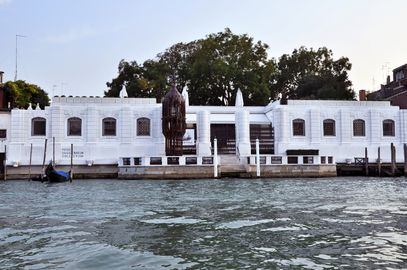

Perhaps the most fascinating thing about this museum is not the collection itself, but the particular building that houses it. It was the Venier family who in mid 18th century commissioned architect Lorenzo Boschetti to construct what would have been one of the biggest family palaces on the Grand Canal. The project, however, never got beyond the first floor because the Veniers ran out of money. For about one hundred and fifty years the building was uninhabited until Milanese noblewoman Luisa Casati purchased it in 1910. There she entertained all the European bluebloods, organized literary salons and in the gardens kept a wide array of exotic animals, such as cheetahs and peacocks. She sold the building in 1924.
In 1948 the Venier one-floor palace was purchased by Peggy Guggenheim. Peggy was the niece of the American mining magnate, Solomon Guggenheim. Her father Benjamin had died on the Titanic. At the age of twenty-one she had inherited a 2.5-million-dollar fortune (34 million in today's value) and moved to Paris, where she became a patron of the bohemian artistic community. There she married German painter Max Ernst. After buying the Palazzo Venier dei Leoni she transferred her private collection to Venice and continued fostering new artists and acquiring their work. She lived in Venice until her death in 1979. Her ashes, along with those of all her dogs, are interred in the palace gardens, called the Nasher Sculpture Garden.
Today the Peggy Guggenheim Collection is considered one of the most important 20th century art galleries in Italy. It is comprised of works from all the major artistic movements: Cubism, Surrealism and Expressionism. We can find masterpieces from De Chirico, Braque, Duchamp, Dali, Picasso, Miro, Giacometti, Ernst, Kandinsky, Klee, Magritte, Mondrian and others. There are even paintings by Peggy's daughter, Pegeen Vail Guggenheim, who died in the palace in 1967 after overdosing on her anti-depression medication.
After Peggy's death her collection passed to the Solomon Guggenheim Foundation, which had already been running the Guggenheim museums in New York and Bilbao. The Foundation restored and expanded the Venetian palace, purchasing some neighboring properties, thus doubling the exhibition space. Besides Peggy's permanent collection, the museum often hosts temporary modern art exhibits coming from all over the world.